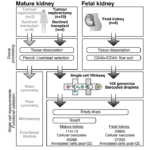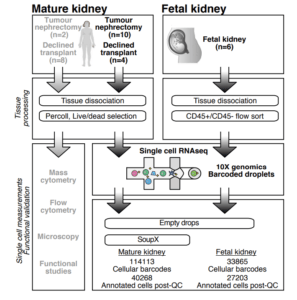The kidney is well known for its role in maintaining bodily homeostasis, however our understanding of immune cellular composition in different kidney anatomical structures is limited. Researchers recently published an article in Science (Stewart et al.,) describing the immune composition of anatomical structures of the kidney, and how they differ between early life (fetus) and adulthood.
Stewart et al., obtained kidney samples from adults (n=14) and fetus at different gestational ages (n=6, 8-16 weeks post-conception [PCW]). They then performed single-cell RNA sequencing (scRNA-seq), flow and mass cytometry to define immune cell and functional composition. Unfortunately, due to sample availability they were unable to perform all three experimental protocols on each sample.
Researchers observed spatial distribution of cells depending on anatomical location. For example, B cells were predominantly in the cortex of the nephron* but virtually absent in medulla and pelvis (of the nephron), while the proportions of mononuclear phagocytes (MNPs) were enriched in the pelvis compared to the medulla and cortex. Interestingly, CD4 T cells detected were heterogenous and based transcriptomic expression were unable to assign a specific T helper lineage. When they examined fetal samples, they detected MNPs, T and natural killer cells as early at 9 PCW, while B cells were only detected from 12 PCW. Suggesting that by birth, immuno-cellular composition of nephrons are similar to adults.
Stewart et al., also measured the transcriptomic functional profiles of sorted cells. Where they showed that functional features associated with antimicrobial immunity were enriched in the pelvic epithelium. Increased expression in this region, could be because it has the closest proximity to the ureter where bacterial infections could originate from. They also showed fetal samples had diminished expression of transcript modules associated with innate immune cells are not mature and have diminished functional properties.
In summary, Stewart et al., “ provides a comprehensive description of immune topology in the human kidney”. Results from this study with facilitate future studies that aim at investigating kidney pathology, and developing therapeutics that can prevent and “manage” kidney diseases.
*nephron: is the microscopic and functional unit of the kidney, that performs the homeostatic function of the kidney.
Journal Article: Stewart et al., 2019. Spatiotemporal immune zonation of the human kidney. Science
Read More : Human kidney map charts our growing immune defence

